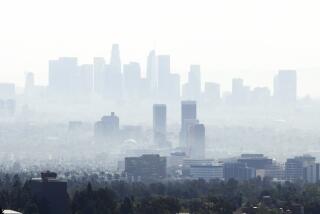Kudzu linked to poor air quality
- Share via
Kudzu, a fast-growing and invasive Asian vine introduced in the American South several decades ago, has now blanketed more than 7 million acres of the region, making it sometimes seem more common than the hallmark azaleas, dogwoods and peach trees.
Now there’s evidence that the plant also increases air pollution.
FOR THE RECORD:
Kudzu and air quality: An article in Saturday’s LATExtra section about research linking the vine kudzu to air pollution referred to ozone as a colorless and odorless gas. In its concentrated form, ozone has color and odor. It is colorless and odorless to humans when diluted with air as ground-level ozone. —
A paper published Monday in the Proceedings of the National Academy of Sciences reported a link between kudzu and the production of ozone, the colorless and odorless gas that is the main component of smog. Ozone can damage lung tissue, increasing inflammation and the risk of asthma attacks.
Some crops and plants are known to contribute to ozone. But this study is the first to establish a connection between an invasive plant and poor air quality, said lead researcher Jonathan Hickman, a fellow at the Earth Institute at Columbia University.
“Tying the two together is an important aspect of this research,” said UC Davis plant sciences professor Arnold Bloom, who was not involved in the work. The findings suggest yet another way to assess the effects of invasive species.
Kudzu was planted widely in the Southeast in the early 20th century to help control erosion. But it grew almost too well, not just controlling soil erosion, but taking over abandoned farmland and climbing over stands of native plants, including trees.
A legume, it captures nitrogen from the air and transfers it into surrounding soil.
Normally this is a good thing, Bloom said. Plants need nitrogen to grow. Until nitrogen from the air is broken down into an easier-to-digest form by “nitrogen-fixing” plants and bacteria that work with them, other plants can’t access it.
“But there’s a downside,” Bloom said. The nitrogen-rich soil around kudzu can also emit gases that react with chemicals known as volatile organic compounds, creating ozone.
To measure kudzu’s effect on ozone emissions, Hickman and his colleagues identified three locations in Madison County, Ga., where they could study paired plots, or sites where patches of soil covered by kudzu sat next to nearly identical patches of soil without the plant.
They found that the presence of kudzu more than doubled the concentration of nitric oxide coming from the soil.
Plugging their data into a computer scenario in which kudzu covered all nonagricultural, nonurban soils in the region by 2050, they then calculated that, in some areas — specifically parts of Mississippi, Arkansas and Tennessee — the number of “high-ozone events” would increase by as many as seven days per year, up more than 35% compared with another hypothetical scenario without kudzu.
A high-ozone event was defined as occurring when ozone levels reach 70 parts per billion. The Environmental Protection Agency air-quality standard for ozone is 75 parts per billion. The agency has proposed changing the standard to 60-70 parts per billion.
Aside from altering the visual landscape, invasive species can crowd out native plants, upending long-established, but fragile, ecosystems.
In the Southeast, kudzu is “a poster child for invasive species,” Hickman said. Only a few other plants can coexist with it because it grows so dense in summer months that it allows less light through to the ground than a mature forest does.
In addition to facilitating the release of nitrogen oxides from soils into the air, kudzu emits isoprene, a volatile organic compound. “Kudzu is kind of like nature’s tailpipe — a tiny ozone machine,” Hickman said.
The vine also thrives in carbon-dioxide-rich air, so it may spread even more quickly, and farther north, as atmospheric carbon dioxide increases, Hickman said.
The outlook isn’t completely dire. The computer simulation in this study posited “an extreme case, not a plausible scenario.”
Kudzu is spreading rapidly — about 100,000 to 125,000 acres each year, Hickman said. It has taken root as far north as Maine and Ontario, Canada, but because it thrives in hot, humid environments, is unlikely to become a scourge far outside the Southeast.
Still, Hickman said, the research brings new attention to yet another consequence of species invasion.
“I’m not sure you’d see an impact on air quality that would cause you to worry from a policy or a health perspective,” he said. “But atmospheric air quality hasn’t been part of the conversation about invasive species. Maybe it should be in the future.”
Eric Davidson, a senior scientist at the Woods Hole Research Center, a nonprofit institute in Massachusetts that studies the environment, said of the findings: “This means it’s more difficult than previously thought to reach our goals of reducing ozone in the lower atmosphere, because the world is a complex place.” He did not take part in the research.
“That doesn’t mean we shouldn’t try to reduce these emissions,” Davidson said. “But there’s no silver bullet that will solve the problem when there are multiple sources” of nitrogen oxides.







